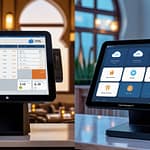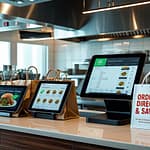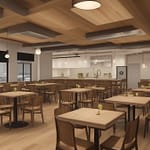Key Takeaways:
- Evaluate your current kitchen operations to identify areas where a KDS system could improve efficiency and accuracy.
- Consider the scale of your restaurant; larger operations may benefit more significantly from kitchen automation.
- Understand the capabilities of different KDS systems to ensure you choose a platform that aligns with your specific needs.
- Factor in the cost of a KDS system, including installation and training, and weigh it against potential increases in productivity and customer satisfaction.
- Regularly reassess the effectiveness of your KDS system once implemented to ensure it continues to deliver value and meet your restaurant’s needs.
Do You Really Need a KDS? Here’s How to Decide
KDS systems explained for restaurant owners
In today’s fast-paced restaurant industry, efficiency and accuracy in the kitchen are key to success. With technology advancing rapidly, many restaurant owners wonder if investing in a Kitchen Display System (KDS) is truly necessary. Kitchen automation tools like a KDS promise streamlined operations, reduced errors, and improved communication—but do these benefits justify the investment for your specific business?
Before you decide if a KDS system fits your restaurant, let’s break down exactly what it is, explore its practical benefits, and examine real-world examples of how it has impacted restaurants similar to yours. By the end of this article, you’ll have a clearer understanding of whether kitchen automation is right for you.
What Is a Kitchen Display System (KDS)?
A Kitchen Display System (KDS) is a digital platform designed specifically for restaurant kitchens, replacing traditional printed tickets with digital displays. Orders placed by your waitstaff or through online ordering platforms appear instantly on monitors installed at cooking stations. This tech tool ensures information flows smoothly from the front-of-house to the kitchen, enhancing communication and efficiency.
While traditional paper tickets can easily be lost, misread, or become illegible, a KDS clearly displays all orders, modifications, and requests in real-time. As a result, kitchen staff can work faster, reduce mistakes, and ensure guests receive exactly what they ordered, every time.
The Benefits of Implementing a KDS System
A KDS system offers several tangible advantages for restaurants of varying sizes and concepts. Here are some of the most impactful benefits:
1. Improved Order Accuracy
Miscommunication between the front-of-house and kitchen often results in order errors, leading to dissatisfied customers and increased food waste. A KDS system significantly reduces these errors by clearly displaying each order detail and modification in an organized, readable format. This accuracy helps your kitchen staff fulfill orders correctly the first time.
2. Enhanced Kitchen Productivity
Kitchen automation minimizes manual tasks, such as collecting, sorting, and managing paper tickets, allowing your cooks to focus purely on food preparation. By having orders automatically displayed and prioritized, your kitchen team can work more efficiently and increase overall productivity.
3. Faster Order Turnaround Times
With digital tickets appearing instantly, your kitchen staff can begin preparing dishes immediately upon receiving them. Additionally, a KDS system often provides time-tracking features that can help cooks monitor preparation times, set benchmarks, and optimize their workflow. This leads to quicker service, happier customers, and increased table turnover rates.
4. Real-Time Order Tracking and Communication
Kitchen Display Systems provide real-time visibility of orders, allowing your front-of-house staff to stay informed at every stage. Servers can promptly update customers about their order status, resulting in improved customer satisfaction and higher service quality.
5. Reduced Costs and Environmental Impact
By eliminating paper tickets, your restaurant can significantly reduce costs associated with printing supplies and equipment maintenance. Going digital also decreases paper waste, supporting your business’s sustainability initiatives and positively impacting your environmental footprint.
When Should a Restaurant Consider a KDS System?
While the benefits are clear, not every restaurant may find a KDS equally valuable. To determine if kitchen automation is right for your establishment, consider the following scenarios:
Your Restaurant Experiences High Order Volumes
If your kitchen regularly handles high volumes of orders, especially during peak hours, a KDS system can dramatically improve workflow efficiency. By streamlining communications and reducing confusion, your kitchen team can handle increased demand without compromising quality.
Your Menu Is Complex or Customizable
Restaurants offering extensive menus or customizable dishes benefit greatly from advanced organization and clarity provided by a KDS. With multiple modifications and special requests, traditional printed tickets become cluttered and difficult to manage. Digital displays simplify this complexity, ensuring accuracy in every order.
You Aim to Improve Staff Communication
Effective communication between your front-of-house and kitchen teams is crucial for smooth operations. If your team regularly experiences miscommunications or delays, a KDS can bridge this gap, ensuring everyone has real-time access to accurate order information.
You Seek to Streamline Online Ordering and Delivery
With online ordering and delivery becoming essential revenue streams, restaurants must handle multiple order channels seamlessly. A KDS integrates orders from various platforms into one centralized location, simplifying management and preparation to ensure timely deliveries and satisfied customers.
Case Studies: Restaurants Benefiting from KDS Systems
Real-world examples illustrate how KDS systems can positively impact diverse restaurant settings:
Case Study: Quick-Service Restaurant (QSR)
A popular burger chain implemented a KDS across multiple locations to address frequent order inaccuracies and long wait times. After installation, order accuracy improved by 35%, and turnaround times decreased significantly. Cooks reported greater clarity and less stress during peak hours, ultimately enhancing the customer experience.
Case Study: Full-Service Restaurant
A busy full-service restaurant known for its customizable pasta dishes experienced regular miscommunications between servers and kitchen staff. After adopting a KDS system, order errors dropped by nearly 50%, allowing staff to focus more energy on food quality and presentation. Customer satisfaction scores rose, and negative reviews related to order mistakes decreased dramatically.
Case Study: Independent Café
An independent café offering online ordering and delivery faced challenges managing multiple orders from various channels. Implementing a KDS helped centralize all incoming orders, streamlining kitchen operations and reducing confusion. As a result, the café increased order capacity by 20%, boosting revenue and efficiency.
Factors to Consider Before Investing in a KDS System
Before committing to a KDS, carefully evaluate these key factors:
- Budget: Assess upfront costs, including hardware, software, and ongoing maintenance fees.
- Staff Training: Determine if your team will require extensive training and if the technology matches their skill level.
- Integration: Ensure compatibility between your chosen KDS and existing POS systems or online ordering platforms.
- Space Constraints: Evaluate kitchen layout to determine optimal placement of KDS monitors and equipment.
- Scalability: Choose a KDS system that can grow with your business, allowing for additional stations or locations in the future.
Making the Decision: Is a KDS Right for Your Restaurant?
Ultimately, the decision to incorporate a Kitchen Display System into your restaurant’s operations should align with your specific needs, challenges, and goals. Carefully review your current processes, identify pain points, and assess the potential benefits outlined above.
If your restaurant frequently struggles with order accuracy, kitchen efficiency, or communication breakdowns, a KDS could offer significant improvements. Conversely, smaller establishments with straightforward menus and consistently low order volumes may find the investment unnecessary.
Consider starting small by testing a KDS system at a single station or during specific periods to evaluate its effectiveness. Many restaurant owners begin with pilot programs before fully committing to full-scale kitchen automation.
Conclusion
Kitchen Display Systems offer restaurant owners a powerful tool to streamline kitchen operations, improve accuracy, reduce costs, and enhance customer satisfaction. By examining your restaurant’s unique circumstances and carefully weighing the advantages against upfront costs and implementation challenges, you can confidently decide if kitchen automation technology is the right step forward.
Ultimately, choosing the right tech tools for your restaurant—whether a KDS or other innovations—can position your business for sustained growth, operational excellence, and long-term success.






Comments
Be the first to comment on this article.